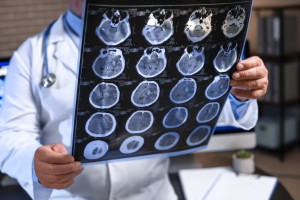For these diseases, a disability certificate with no validity period is available LIST

Author: AN • Source: Rynek Zdrowia, PAP • Published: 06 July 2025 21:25
Two lists of diseases for which permanent disability certificates can be granted are ready. The government's plenipotentiary for disabled people has issued recommendations in this matter.
- The Ministry of Family, Labor and Social Policy has announced important changes in the procedures for issuing disability certificates.
- Guidelines have been created for adjudicating teams on issuing decisions without a validity period, i.e. permanently
- Two lists of diseases for which such a decision can be issued have also been developed. The first one contains 150 diseases, the second 58.
MRPiPS reminded that the essence of the current disability assessment system is to assess whether a given person's health condition prevents them from fulfilling specific social roles on an equal basis with other people. It is important whether the health condition, according to current medical knowledge, gives a chance for improvement, as well as how the person functions in their local environment.
The social side has repeatedly pointed out that many people suffering from rare diseases or Down Syndrome, for example, face misunderstanding in adjudicating teams. - There were situations in which it was considered that the health condition of these people could improve, despite other opinions presented by specialists in the field of clinical genetics - indicated the ministry.
In response, Deputy Minister of Family Łukasz Krasoń issued recommendations for the Provincial and District Disability Assessment Teams.
- People suffering from nearly 150 rare diseases, if they contact these teams and document their condition, will receive a permanent disability certificate (in the case of children up to 16 years of age) taking into account points 7 and 8 of the certificate.
- Point 7 means the need for constant or long-term care or assistance from another person due to the significantly limited possibility of independent existence, and point 8 - the need for constant, everyday participation of the child's guardian in the process of his or her treatment, rehabilitation and education).
- In the case of children with Down syndrome and those suffering from 50 other rare diseases, a similar recommendation was issued regarding decisions issued for the maximum possible period (up to 16 years of age) and the need to apply point 7 of the decision.
The granting of a ruling to such persons is associated with the guarantee of:
- care benefits,
- care allowance,
- tax relief (e.g. the possibility of deducting care expenses under the rehabilitation relief);
- priority access to social and care services;
- facilities for accessing health services - e.g. rehabilitation,
- sanatorium treatment,
- the right to a Parking Card; additional support in education (the possibility of obtaining an assistant at school or an individual course of study).
The guidelines with a detailed list of diseases were received from the Ministry of Family, Labor and Social Policy and published by Prawo.pl. The website emphasizes that they do not have statutory status, but are merely indications that a medical expert may use.
- Conditions , in the case of confirmation for which the assessed child is justified in qualifying as disabled with the indication established in point 7 - the need for constant or long-term care or assistance from another person due to the significantly limited possibility of independent existence and the indication established in point 8 - the need for constant daily participation of the child's guardian in the process of his/her treatment, rehabilitation and education for the period until he/she reaches 16 years of age:
- Achondroplasia
- Aicardi-Goutières Syndrome
- Alpha 1 antitrypsin deficiency - homozygous form
- Alpers-Huttenlocher Syndrome
- Alpha- and beta-mannosidosis
- Alström's Syndrome
- Angelman Syndrome
- Apert Syndrome
- Aromatic L-amino acid decarboxylase deficiency
- Ataxia telangiectasia
- Autosomal recessive polycystic kidney disease
- Autosomal recessive malignant osteopetrosis
- Bardet-Biedl Syndrome
- R4 Limb-girdle muscular dystrophy associated with beta-sarcoglycan
- CHARGE Team
- Calpain-3 R1-related limb-girdle muscular dystrophy
- Campomelic dysplasia
- Canavan disease
- Heller's Syndrome (Childhood Disintegrative Disorder, CDD)
- Cockayne Team
- Coffin-Lowry Syndrome
- Congenital absence of arm and forearm
- Congenital disorder of glycosylation
- Congenital muscular dystrophy with alpha-7 integrin deficiency
- Cornelia de Lange's Team
- Cystic fibrosis
- Dravet syndrome (SCN1A-related)
- Dubowitz Syndrome
- Duchenne muscular dystrophy
- Simple epidermolysis bullosa
- Fetal akinesia deformational sequence
- Fragile X Syndrome
- Fraser Syndrome
- Friedreich's ataxia
- Fryns's Syndrome
- GM1 Gangliosidosis
- GM2 Gangliosidosis
- Gaucher's disease
- Glycine encephalopathy (nonketotic hyperglycinemia)
- Underdevelopment of the distal part of the limb/limbs, hemimelia
- Holoprosencephaly
- Hutchinson-Gilford Progeria Syndrome
- Hydrocephalus with stenosis of the aqueduct of Sylvius
- Hyperphenylalaninemia caused by tetrahydrobiopterin deficiency
- Hereditary epidermolysis bullosa
- Smooth brain - a congenital defect of the central nervous system
- Isolated anencephaly/exencephaly
- Isolated open spina bifida
- Isovaleric acidosis
- Huntington's disease, juvenile form
- Kabuki Team
- Krabbe disease
- Kyphoscoliotic type of Ehlers-Danlos syndrome
- Congenital muscular dystrophy due to lamin alpha 2 deficiency, merosin-negative congenital muscular dystrophy
- Larsen's Syndrome
- Leber's congenital amaurosis
- Leber's hereditary optic atrophy
- Leber's disease "plus"
- Leigh's Syndrome
- Lesch-Nyhan Syndrome
- Maternal phenylketonuria with microcephaly
- Meckel's Syndrome
- Menkes disease
- Metachromatic leukodystrophy
- Miller-Dieker Syndrome
- Mitochondrial Membrane Protein-Related Neurodegeneration
- Niemann-Pick disease type A
- Niemann-Pick disease type B
- Niemann-Pick disease type C
- Team Nijmegen
- Noonan Team
- Ohtahara's Syndrome
- Congenital brittle bone disease
- Congenital osteogenesis imperfecta with deformities
- Pelizaeus-Merzbacher disease
- Pompe disease
- Prionopathies (familial)
- Rett Syndrome
- Refsum's disease
- Rubinstein-Taybi Syndrome
- Sandhoff Syndrome
- Smith-Lemli-Opitz syndrome
- Smith-Magenis Syndrome
- Sturge-Weber syndrome
- Tarui's Team
- Timothy's Team
- Tuberous sclerosis
- Tay-Sachs disease
- Treacher Collins Syndrome
- Turcotte's Syndrome
- Usher Syndrome
- VATER/VACTERL Team
- Waardenburg Syndrome
- Warburg Syndrome
- Williams Team
- Wolf-Hirschhorn Syndrome
- Wilson's disease
- Zellweger Syndrome
- Zollinger-Ellison syndrome
- Prader-Willi syndrome
- Kabuki Syndrome with a mutation in KDM6A
- Kabuki Syndrome with a KMT2D Mutation
- Angelman Syndrome Associated with UBE3A Mutation
- Smith-Magenis syndrome with deletion 17p11.2
- Smith-Magenis syndrome with RAI1 mutation
- Cri du chat team
- Trisomy 13 (Patau syndrome)
- Trisomy 18 (Edwards syndrome)
- Trisomy 21 (Down syndrome)
- Turner Syndrome
- Klinefelter's Syndrome
- Coffin-Siris Syndrome
- Cornelia de Lange Syndrome with SMC1A Mutation
- Cornelia de Lange Syndrome with SMC3 Mutation
- Cornelia de Lange Syndrome with RAD21 Mutation
- Cornelia de Lange Syndrome with NIPBL Mutation
- Cornelia de Lange Syndrome with HDAC8 Mutation
- Cri-du-chat team (5p minus)
- Wolfram Syndrome
- Joubert Syndrome
- Alagille Syndrome
- Hermansky-Pudlak syndrome
- Kartagener's Team
- Leigh syndrome (mitochondrial form)
- Mitochondrial encephalopathy (MELAS)
- Mitochondrial myopathy
- Kearns-Sayre Syndrome
- Leigh disease (SURF1 mutation)
- Mitochondrial disease with a mutation in mtDNA
- Mitochondrial encephalopathy with POLG mutation
- Mitochondrial myopathy with TK2 mutation
- Aarskog's Team
- Classic Ehlers-Danlos Syndrome
- Vascular Ehlers-Danlos syndrome
- Marfan Syndrome
- Loeys-Dietz Syndrome
- Stickler's Syndrome
- Shprintzen-Goldberg syndrome
- Diastrophic dysplasia
- Osteogenesis imperfecta type III
- Osteogenesis imperfecta type IV
- Ellis-van Creveld Syndrome
- Achondrogenesis
- Hypochondroplasia
- Thanatophoric dysplasia
- Emery-Dreifuss muscular dystrophy
- Late-onset muscular dystrophy
- Thomson's congenital myotonia
- Nemaline myopathy
- Kabuki Syndrome with MLL2 Mutation
- Conditions , in the case of confirmation for which the assessed child is deemed to be entitled to disability status, with the indication provided for in point 8 - the need for constant, everyday participation of the child's guardian in the process of his or her treatment, rehabilitation and education for the period until he or she reaches 16 years of age.
- 22q11.2 Microdeletion Syndrome (DiGeorge Syndrome)
- Congenital polyarticular stiffness, arthrogryposis
- Autosomal dominant cerebellar ataxia
- Autosomal recessive cerebellar ataxia
- Barth's Syndrome
- Cardio-facio-cutaneous syndrome (CFC)
- Carnitine palmitoyltransferase (CPT) deficiency
- Charcot-Marie-Tooth disease (hereditary sensory and motor neuropathy)
- Classical galactosemia
- Classic homocystinuria
- Congenital chlorotic diarrhea
- Congenital hydrocephalus
- Congenital myasthenic syndrome
- Segawa's disease, dystonia with good response to L-DOPA
- Emery-Dreifuss muscular dystrophy
- FKRP-related limb-girdle muscular dystrophy
- Gamma-sarcoglycan-related limb-girdle muscular dystrophy
- Glutaryl-coenzyme A dehydrogenase deficiency (Glutaric acidemia type 1)
- Glycogen Storage Disease GSD
- Hartnup disease
- Hemophilia A, severe form
- Hereditary angioedema
- Hereditary spastic paraplegia
- Holocarboxylase synthetase deficiency
- Incontinence of pigment - Bloch-Sulzberger syndrome
- Thoracic constriction dysplasia - Jeune's syndrome
- Johanson and Blizzard Team
- Joubert Syndrome and Related Disorders
- Long-chain fatty acid dehydrogenase 3-hydroxyacyl CoA deficiency
- Mitochondrial encephalopathy, lactic acidosis with stroke-like episodes - MELAS syndrome
- Medium Chain Acyl-CoA Dehydrogenase Deficiency
- Microphthalmia-aphthalmia syndrome
- Gastrointestinal mitochondrial encephalomyopathy
- Mitochondrial oxidative phosphorylation disorder due to mitochondrial DNA abnormalities
- Trifunctional mitochondrial protein deficiency
- Multiple system atrophy
- Parkinson's type multiple system atrophy
- Orofacial-digital syndrome type 1
- Pfeiffer's Syndrome
- Phenylketonuria
- Childhood-onset spinocerebellar ataxia
- Steinert's myotonic dystrophy
- Tracher-Collins Syndrome
- Tuberous sclerosis
- Tyrosinemia type 1
- Werner's Syndrome
- Early onset Parkinson's disease
- Loeys-Dietz syndrome
- Borjeson-Forssman-Lehmann syndrome
- Sensenbrenner Team
- Arnold-Chiari syndrome type 1
- Fanconi's anemia
- Allagille Syndrome
- Maple syrup urine disease
- Hypophosphatasia
- Pompe Syndrome
- X-linked hypophosphatemic rickets
- Freeman-Sheldon Syndrome
Copyrighted material - reprint rules are specified in the regulations .
rynekzdrowia













